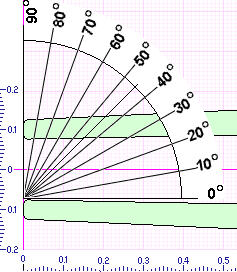Making Tips
Illuminated Tips
|
|
|
|---|
|
Making Tips Illuminated Tips |
Thoughts on Instrumental Insemination Tip Shape |
|---|
Having looked at some "normal" tips under the microscope they seem somewhat like the top of a milk bottle. Even after flame polishing they still seem somewhat blunt. The outside diameter at the tip needs to be 0.25 mm or 0.27 mm with a maximum of 0.3 mm. The Inside diameter at the tip needs to be 0.15 mm to 0.17 mm 0.15 mm is most common and 0.17 mm or more will give problems with mucous.
All diagrams indicate cross sections through the tips.

The tip illustrated is about 35 mm long and made from 2 mm diameter "green band" capillary tubing, the straight portion is not shown to give greater clarity to the drawn down section. Providing that the heating of the glass is even then the tube will stay in ratio, wall thickness to diameter, as it reduces in diameter. However there is a temperature gradient that causes less draw to occur at the thickest portion of the melted glass. Most tips are about 35 mm long, but those for use in the Schley syringe need to be 85 mm - 90 mm long.
Many different styles of tip shape are possible and no doubt some have particular favourites. A trend that I have noticed recently is to use tips that have a much shorter and more blunt drawn section, this gives a more severe taper to the insertion portion and so gives a tapered plugging action that helps with sealing.

The very short version at left is probably taking this technique too far, but the centre and right hand draws are achievable and feasible.
|
Scale = each small square is 0.01 mm. Cutting or grinding the mouth of the tip at various angles is being tried by some. |
|
If you consider the cross section:-
|

|
|---|
|
The proposed shapes are derived from the diagram at right. The normal shape being 90 ° The shallower the angle selected the easier insertion will be, but at the shallowest angles the risk of leakage is increased and also as the angle increases the orifice gets larger and may give problems with mucous pick up. Tips with angles of between 70 ° and 80 ° are currently being distributed (although the samples that I have seen are somewhat sharp on the edges and could do with a minor amount of dressing then re-polishing). These new shapes give improvements in the penetration resistance graphs. The versions previously shown on this page were too crude and too shallow in the cutting. |

|
|---|
|
The improvements give easier entry of the tip with a much reduced risk of damage to the queen. The tapered portion immediately behind the tip may need to have a slightly steeper taper to effect a seal without penetrating too far. NOTE... The taper starts at the inner wall of the tube, reducing the "sharpness". The shape can be produced by grinding. The tip should be supported in a beeswax bed in a "U" shaped channel (something like an umbrella rib) and the grind done with a "Dremel" type tool running at about 30,000 RPM. A smooth finish is achieved using flame polishing. If you examine an insulin syringe needle you will see that the sides of the chamfered end are also relieved. If this was done to our glass tips, but in a very minor and more blunt fashion, before the flame polishing, then the penetration resistance is reduced still further. (John Harbo reports that he uses similar chamfered tips.) |
|
|---|
|
|
|
|
|
If a truly right angled tip is required, for any reason, the method indicated on the illuminated tips page should be used. |
|
|
None of the items on this page are 'set in stone', comments and discussion are welcomed... By either direct Email or via the Instrumental Insemination Discussion List.
Written... Autumn 2000, Revised... 30 October 2001, Upgraded... 24 December 2005,
|